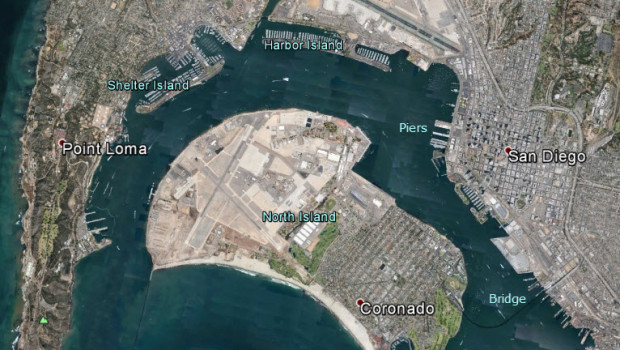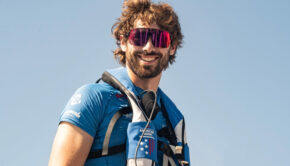The ‘San Diego Plan’ to host the 35th America’s Cup
Published on June 16th, 2014
The venue search for the 35th America’s Cup has narrowed the finalists to Bermuda, Chicago and San Diego. The leader among the venues appears to be San Diego, which has both consistent weather and event experience. The plan is for the racing to be held inside San Diego Bay.
“San Diego clicks a lot of boxes,” remarked defense CEO Russell Coutts. “The boats might be maneuvering every minute and a half. It would be a highly technical course in the AC 62 and would lay out quite well for spectators and sponsor fulfillment.”
The ‘San Diego Plan’ uses two downtown cruise ship terminals for the activity hub. The teams will be based at the B Street Pier while the adjacent Broadway Pier will be the public village. The start and finish would be off the Broadway Pier, with the course extending from Coronado Bridge to Harbor Island.
Involved in the San Diego bid is Troy Sears, who helped form Sailing Events Association (SEA) San Diego to promote major sailboat racing events in San Diego for the benefit of the local economy. Troy provides an update on the selection process…
What gives San Diego the confidence to host the America’s Cup?
The leadership of the Port of San Diego understands they have some very valuable assets, such as the B Street Pier and the Broadway Pier, and have made the commitment to maintain them. These piers are in great condition and well suited for a variety of uses.
As a result, to host the America’s Cup, we won’t have large capital costs needed to make improvements. Our infrastructure is ready to go. We can formulate a plan that does not require investment. The Broadway Pavilion is a fantastic facility for hosting events, and it is ready to go. This is a substantial difference from the other cities.
Additionally, we have hosted the America’s Cup before. The event has been here in ’88, ’92 and ’95, with the event in ’95 ending in the black. We know the 2017 event has to financially perform, and we understand how to make that happen.
Explain the sailing venue.
What we propose to do with the race course, positioning it in the Bay, has already proven itself successful when we hosted an RC44 class regatta and the AC World Series in 2011. Through those events, it was demonstrated that San Diego Bay is a tremendous venue for stadium sailing.
The natural landscape brings people close to the event, and it will be the harbor that defines the course. This will make it very easy for fans to recognize that when boats get to the edge of the course, they will need to turn. If boats don’t turn, they will hit the shoreline. The boundaries will be very understandable.
Additionally, the public is going to have a great view of the team bases. Watching the boats get launched, and seeing the wings get raised and lowered, is quite a show, and something the public missed out on during the 2013 America’s Cup.
What are some of the other advantages for San Diego?
We may not have strong winds on a regular basis, but we always have wind in the afternoons. The consistency of our conditions will insure the schedule will not be affected; racing will happen when it is supposed to happen. So with minimal investment needed, and solid political support, I like our chances.
Why does the venue selection take so much time?
The process takes time to generate local support once a city has been notified that their bid has been accepted. You have to educate government; you have to educate the community entities that you hope will provide financial support. That’s not a one day, one week, one month process.
Since we were notified at the start of the year, the organizational group in San Diego, which is lead by the Port of San Diego, has been working very diligently. Additionally, all the community supporters, lead by SEA San Diego, are putting in a full-time effort as well. From our perspective, we don’t see the process dragging on. Quite the opposite, we feel we need all this time to fulfill the requirements and meet the deadlines.
These events are complicated. They require a huge commitment by local cities. The assets must get lined up, such as the piers, along with the services such as fire and police. Time is also needed to sort out the city codes that may impact the organizational plan.
We understand that the challengers need to know the venue location, and every sense I have gotten is that everyone is pushing as hard as possible to make that happen.
What kind of support is needed to host the event?
While we are pursuing local corporate support, what the America’s Cup Event Authority is looking for is broad support. They want to insure that our community is behind the event and will support it. From the political sector, the public sector, and the business sector, San Diego has demonstrated loud and clear that this support is in place.
When the America’s Cup had previously been in San Diego, it was not a hugely popular event. What makes the City think the 35th America’s Cup will be an attraction?
The previous events were held 3 miles off the coast. The team bases were scattered around the harbor and curtained off. It was pretty hard for people to know what was going on. And even when you went out on the ocean to watch, the motion of the ocean was not comfortable for a lot of people. However, the event has now evolved, and this new model in the Bay, in front of the City, and accessible from shore, is a huge change. The interest already is phenomenal.
Note: The field of finalists will be narrowed to two venues by the end of June. The final venue is to be selected no later than December 31, 2014.









 We’ll keep your information safe.
We’ll keep your information safe.